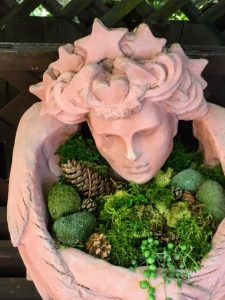Protecting the Garden Warrior
Take a hard look at your fellow gardeners. Hands covered with thick gloves, backed by cool cloth in the summer and fronted by waterproof warm palms in the winter. Sturdy shoes ready to push shovels deep into the earth. Armed with a gardening apron or many pockets holding sharp Felco pruners, hori hori knife, and a three-pronged hand hoe. A large bucket resembling a quiver full of loppers, tree hand saw, and axe. Add a garden hat that repels sun, wind, and rain that covers you like a helmet. A face covered with dirt resembling war paint or streaked with sweat or tears. This is a garden warrior.
Being a garden warrior has moments that may sink into dangerous. Every profession has its slogans; for Emergency Medical Services (EMS) there are many. Here is an ambulance favorite, “You fall, we haul”. Another one, “When in danger or doubt, get a chopper and fly them out”. Ringing your bell by getting knocked out by a falling limb can earn you a ride with the EMTs. Common sense and some home first aid may save you from that ride with lights and sirens.
Many garden mishaps are home treatable. Who hasn’t been using their pruners and nicked their femoral artery? Wait, Stop! Femoral artery, call the medics! However, a small nick of your skin is controllable. The extent of your injury is determined by the color of the blood and the speed it is coming out of the wound. The smallest blood vessels are capillaries that will trickle and stop on their own with light pressure.
If the wound is a nick with slight bleeding, here is what to do. Wash your hands and, if you are helping someone else, glove up. Rinse the wound with water, cover the wound with gauze or a clean cloth, and apply direct pressure to stop the blood flow and encourage clotting. If possible, elevate the part of the body that is bleeding. Add additional cloth material if the blood soaks through; keep the initial cloth in place for clotting. Once the bleeding has stopped, apply a new bandage. If you find the bleeding continuing it is time to get professional help.
So…checking out your biceps in the mirror this morning leads you to draw the conclusion that a 24-inch box tree is completely moveable by yourself. An eight-foot, freshly-watered tree in the bed of your pickup truck might be overwhelming to every muscle, ligament, and joint in your body. A sprain may be caused by a twist, a pull, or a lift that injures ligaments or muscles. Oftentimes, sprains do not require emergency treatment. It is time to visit the doctor if the pain is severe, there is the inability to bear weight on the injured body part, you notice increased bruising, or no improvement in the upcoming week.
When your body advises you it is in pain, start first aid. Leave the tree and box in your driveway. Moving it around the yard will only make things worse. Quit moving the sprained limb, apply a cold pack, elevate the injured area if possible, and use NSAIDs for pain. A handy way to remember how to treat a sprain is R.I.C.E. or rest, ice, compression, and elevation.
Many insects and birds find attacking garden warriors to be fun or tactical. The groups that frequently have their sabers rattling for gardeners include bees and wasps. Bee stings are painful for some, deadly for others. If you are stung, get the stinger out as quickly as possible. That will stop additional venom from entering the body. Wash the area with soap and water. Apply an ice pack to reduce swelling by wrapping the pack in a clean towel. Use an antihistamine (allergy medication) to reduce swelling and itching. If there is pain, use acetaminophen or ibuprofen. If you are allergic to bee stings get professional help immediately.
Being prepared during an emergency means you have the knowledge to deal with the situation, tools like a complete first aid kit, and common sense to seek help when necessary. Every-day first aid knowledge is available through the Red Cross, many books including the Boy Scout Manual, and reputable sites on the internet.
The best way to deal with gardening mishaps is to carry common sense in one of your gardener warrior pockets and lots of band-aids in the other.
Julie Silva is a University of California Cooperative Extension Master Gardener of Tuolumne County (actually she lives in Stanislaus County, but received her training in Tuolumne County).

